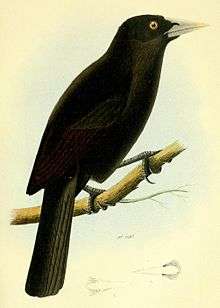Ecuadorian cacique
| Ecuadorian cacique | |
|---|---|
 | |
| Scientific classification | |
| Kingdom: | Animalia |
| Phylum: | Chordata |
| Class: | Aves |
| Order: | Passeriformes |
| Family: | Icteridae |
| Genus: | Cacicus |
| Species: | C. sclateri |
| Binomial name | |
| Cacicus sclateri (Dubois, 1887) | |
The Ecuadorian cacique (Cacicus sclateri) is a species of bird in the family Icteridae. It is found in Colombia, Ecuador, and Peru, where its natural habitat is subtropical or tropical moist lowland forest. A fairly common bird with a wide range, the IUCN has rated it a "species of least concern".
Description
The male Ecuadorian cacique grows to a length of about 23 cm (9 in), with the female being a little smaller. The plumage of both sexes is entirely black, the beak is whitish, long and pointed, and the iris is blue in adults and brown in juveniles.[2] This bird can be distinguished from the otherwise similar solitary cacique (Cacicus solitarius) because that species is larger, has a darker-coloured iris and spends more time in undergrowth and near the ground and less time in trees. Also similar is the red-rumped cacique (C. haemorrhous), but it reveals its bright red rump patch when in flight.[2]
This bird has a number of noisy calls, including a repeated "péach-yo" and "péach-yo-yo", uttered while perched with raised tail, a "k-cheeyow?", and a "kweeyh-kweeyh-kweeyh-kweeyh-wonhh?" among others.[2]
Distribution and habitat
The species is native to southern Colombia, eastern Ecuador and northeastern Peru.[1] It typically lives in moist woodland and the edges of riverside and Várzea forests, at altitudes of up to 400 m (1,300 ft).[2]
Ecology
An arboreal bird, the Ecuadorian cacique usually feeds alone but sometimes pairs of birds or small family groups move together through the tree canopy. It often visits flowering and fruiting trees and can sometimes be seen probing the petioles of Cecropia trees.[2] Its diet is mainly insects such as ants, beetles and caterpillars, as well as fruit and possibly nectar.[3]
Status
C. sclateri has a wide range, its area of occupancy being estimated as 294,000 km2 (113,514 sq mi). The tropical forests in which it lives are being degraded, reducing the area of suitable habitat, however it is a fairly common species, and the rate of any decline in total population is likely to be slow, so the International Union for Conservation of Nature has assessed its conservation status as "least concern".[1]
References
- 1 2 3 BirdLife International (2012). "Cacicus sclateri". IUCN Red List of Threatened Species. Version 2013.2. International Union for Conservation of Nature. Retrieved 22 July 2016.
- 1 2 3 4 5 Ridgely, Robert S.; Tudor, Guy (2009). Field Guide to the Songbirds of South America: The Passerines. University of Texas Press. p. 674. ISBN 978-0-292-71748-0.
- ↑ Fraga, R. "Ecuadorian Cacique (Cacicus sclateri)". Handbook of the Birds of the World Alive. Lynx Edicions, Barcelona. Retrieved 22 July 2016.
